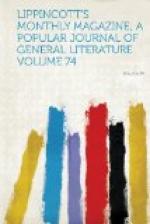The greatest number of marriages for men take place between the ages of twenty and twenty-five in England, between twenty five and thirty in France, and between twenty-five and thirty-five in Italy and Belgium. Finally, in Hungary the number of individuals who marry is seventy-two in a thousand each year; in England it is 64; in Denmark, 59; in France, 57, the city of Paris showing 53; in the Netherlands, 52; in Belgium, 43; in Norway, 36. Widowers indulge in second marriages three or four times as often as widows. For example, in England (land of Mrs. Bardell) there are 66 marriages of widowers against 21 of widows; in Belgium there are 48 to 16; in France, 40 to 12. Old Mr. Weller’s paternal advice, to “beware of the widows,” ought surely to be supplemented by a maxim to beware of widowers.
SHAKESPEARE, in one of his most famous madrigals, draws a vivid contrast between youth and age, which, he declares, “cannot live together:”
Youth like summer morn,
Age like winter weather,
Youth like summer brave,
Age like winter bare:
Youth is hot and bold,
Age is weak and cold.
Science, which ruthlessly destroys so much poetry by its mattock and spade, its scales, foot-rules and gauges, must now, we should judge, take grave exception to the preceding bit of poesy and to the thousand repetitions of its sentiment by the bards of all ages. By means of a thermometer lately constructed to register with exactitude the degree of heat in the human body, it is found, after numerous experiments under varying circumstances, that the instrument marks 37.08 deg. of heat on an average for persons between twenty-one and thirty years of age, while it marks 37.46 deg. for people aged eighty. In face of this fact what becomes of the “fervors of youth” and the “chills of age”? The highest average temperatures in the human body, as indicated by this gauge, are those which exist from birth to puberty—that is to say, 37.55 deg. and 37.63 deg. From the latter epoch the heat gradually lowers, to rise again with the first approach of old age. Thus childhood shows the highest temperature, old age the next, and middle life the lowest. We may add that the greatest variations in the temperature of the body between health and sickness are only a few tenths of a degree, according to this measurement; for, the normal condition being 37.2 deg. or 37.3 deg., an increase to 38 deg. would mark a burning fever, and a decrease to 36 deg. would note the icy approach of death. Hereafter, though we may graciously excuse to poetic license the assertion that




